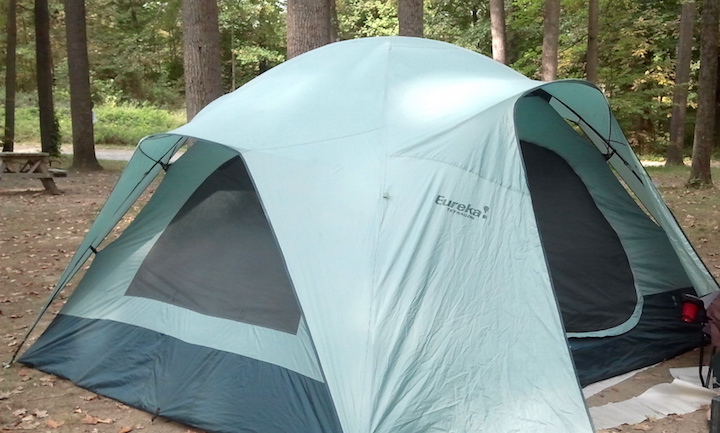
Home | Places We've Been | Nearby Campsites | Getting Started | Recipes! | Camping Style | Packing | Resources
Getting Started:
We used to have a hexagonal L. L. Bean dome tent that was really easy to set up. This is not your father's boy scout tent. The poles have elastic shock cord inside of them and fold into three foot segments. You extend the poles, the shock cord keeps the poles taut, you bend the poles into place, attach the tent clips to the poles and the tent hangs off of the frame. The whole thing gets covered with a waterproof rainfly. Our setup took about five minutes with Roberta helping me.
When the Bean tent's zipper finally gave out after more than fifteen years of use, we replaced the tent in 2012 with a rectangular Eureka tent (Tetragon 6), seen above.
Here's a link to some family tents at Campmor. There are some pretty nice tents here. I'm not a huge fan of the workmanship of the Wentzel tents, but the Coleman and Eureka tents are well worth a look.
Some thoughts:
Don't buy that $40 Walmart tent. If it rains, you, and all of your clothes, sleeping bags and so forth, will get wet. That ends your weekend early on an unpleasant note. Friends of ours were thrilled with their $30 Walmart tent until their white Lab woke up at 2 AM and shook himself off inside the tent!
Get a waterproof footprint to use as a groundcloth under your tent. This will keep you dry should it rain. Ideally, the dimensions should match the dimensions of your tent less one foot; that is, if your tent is say, 5 x 9 feet, you should get a 4 x 8 footprint. This will leave a six inch border of tent on the ground around the footprint. Do not get a footprint bigger than your tent: water will pool on the groundcloth under the tent! By leaving a border, any water under the tent will absorb into the ground. Assuming the tent functions like a bathtub and is watertight at the ground level, you'll stay drier and warmer. We use a nice thick sheet of polyethylene groundcloth from Campmor.
Alternately you can use a blue poly tarp for this. If it's a little too big compared to the footprint of your tent, you can cut it with a scissors to the right size. You can get these at half the cost of the footprint (buy the tarp at Walmart or wherever). I think I got mine for $15-20.
Some tents have an add-on vestibule—essentially a mud room—that can keep your boots dry if it rains. In nice weather, we leave ours off for easier access. Again, you could substitute with a second tarp.

Ignore the ratings such as "four-person tent." Ours is a "six-person" hexagonal tent: we fit the four of us comfortably, but snugly. Also, four-person tents tend to be 4' 11" high. You may appreciate a six-person tent, which tends to be 6 feet high. Look at the dimensions of the floor and see if that seems reasonable. 10 x 10 foot seems about right for a growing family of four. You might also want to invite a friend, so you won't regret having a little extra room.
A tent that has a square footprint will give you more room than one with a hexagonal footprint.
Buy a small bottle of Seam Sealer and use it to go over the sewn seams of the rainfly, the layer that covers the top of the tent. Camping in the rain (god forbid!) is still fun if your tent is keeping you dry.
We camp into October and find that our 20° sleeping bags work fine. You could get lighter 40° bags and augment these with heavy blankets, but I recommend buying bags with the colder rating. Unless you plan on winter camping, 0° rated bags are overkill and will be too hot on summer nights.
You want to have a mattress pad under your sleeping bag. I swear by ThermaRest™ self-inflating pads. We sleep much better since we got them and I no longer feel the twigs and pebbles under the tent floor. Campmor has a house brand that looks decent as well as kid-sized ones at reasonable cost.

That's really all there is to the basics. Campsites typically come with a picnic table and a fire ring. Wood is available from the ranger station, from nearby families or a peddler who brings the wood around the campsites. Bring matches. Bring food. Bring clothing (dress in multiple layers for flexibility). Enjoy!
Here is a link to pictures of some of the stuff we pack in our stuffsacks when we go camping.
—SBW
You are visitor number 2967 since July 2016!
